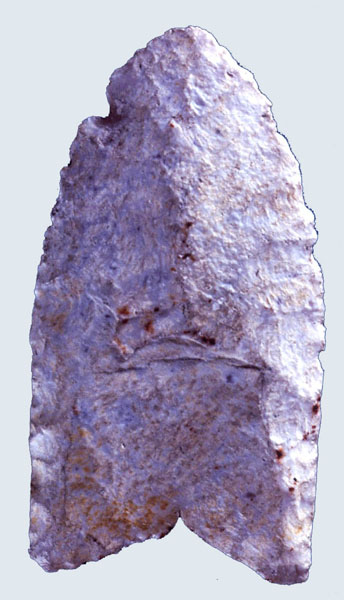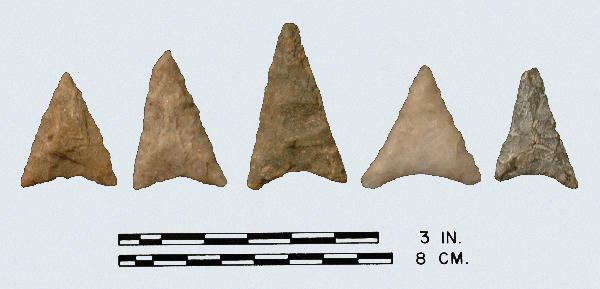
Poplar Island: Top Row: rhyolite, rhyolite, tuff; Bottom Row: quartz, quartz, quartzite, quartzite.
Type Tapering Late-Archaic
Defining Attributes
The Poplar Island is a medium to large, finely flaked, symmetrical point, with a slender isosceles triangular blade. Shoulders are rounded and the constricted stem tapers toward a narrow rounded base.
Chronology
The Poplar Island point dates to the Late Archaic period, 2500 to 1500 BCE. Poplar Island is the second most common point type excavated at the Kent-Hally site on Bare Island. At the Kent Hally site two Poplar Island points were found in association with stone pots. Kinsey (in Ritchie 1971) suggests that this was a Late Archaic type associated with the utilization of steatite bowls.
Description
- Blade: The blade exhibits considerable symmetry in the form of a slender isosceles triangle. Edges are nearly straight with only a slight trace of convexity. Tips and edges are crisp and the tip is always on center with the stem. There is no medial ridge.
- Base: The nonparallel sides of the stem taper toward the base which is the narrowest part of the stem. The lobate base is convex and nearly pointed. Basal corners are always round and never sharp. Edge grinding is frequently present.
- Size: Length ranges from 46 to 86 mm with an average of slightly over 51 mm.
- Technique of manufacture:
Discussion
Poplar Island is one of the types in the long tradition of tapering stem points, starting with Morrow Mountain I and continuing until Rossville. Poplar Island points do not have as well a define shoulder and a more rounded base than the Morrow Mount II point which have pointed shoulders and base. Also, Poplar Island is one of a number of long, narrow points, including Clagett and Bear Island that probably overlap in time. The points only differ slightly in the shape of their base—tapped, side notched, and straight stemmed. When sorting large surface collections of these points, it is often problematic as to which of the three types to place a point.
Defined in Literature
Kinsey originally defined this type in 1959 based on points recovered from the Kent-Hally Site on Bare Island in Pennsylvania. His description of this type was re-published by Ritchie in 1961 (revised 1971).
References




